

SUBSCRIBE TO OUR FREE NEWSLETTER
Daily news & progressive opinion—funded by the people, not the corporations—delivered straight to your inbox.
5
#000000
#FFFFFF
To donate by check, phone, or other method, see our More Ways to Give page.


Daily news & progressive opinion—funded by the people, not the corporations—delivered straight to your inbox.
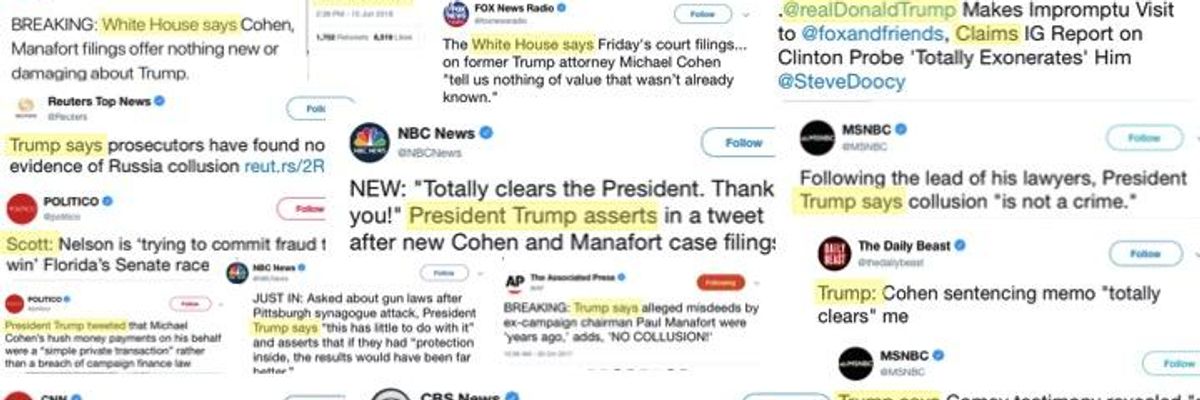
Being too much of a malleable conduit for the messaging of the powerful in Washington has always been a problem for the corporate media.(Photo: Screenshots)
The most basic tenet of professional physicians is the Hippocratic Oath: "First, do no harm." Its intent is clear, simple: When practicing medicine, the fundamental ethical consideration should be to not make things worse. All decisions on treatment--including whether to treat a patient in the first place--flow from that starting point.
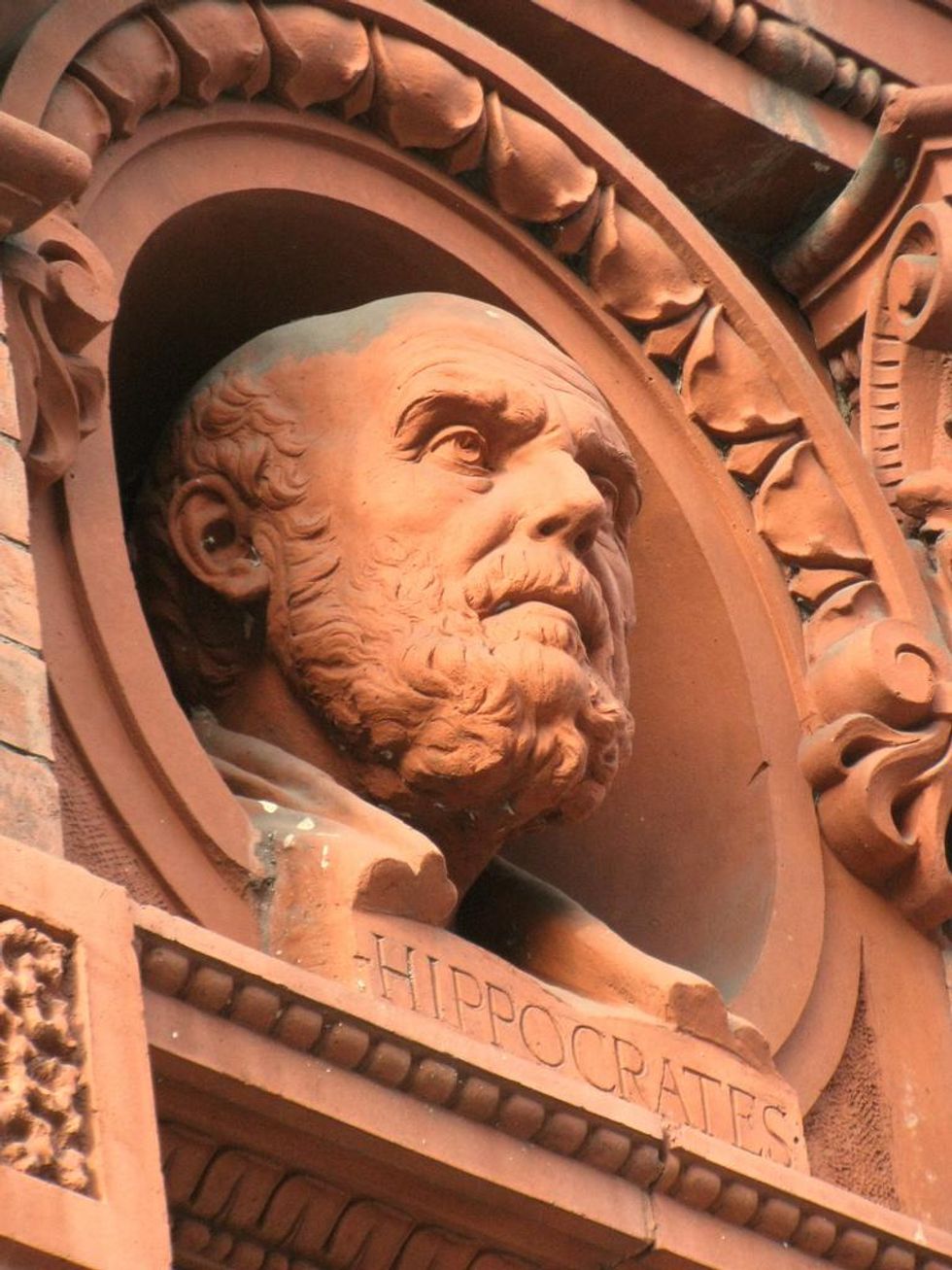
Journalists, while they take no such professional oath, should be duty-bound to follow a similar principle when reporting the news: "First, do no harm to the truth." While our internet-era news ecosystem, like modern medicine, suffers from a number of institutional inefficiencies and dubious remedies--from endless horserace poll stories, to scoops that aren't, to mind-numbingly banal analysis--these editorial efforts should, at the very least, avoid lowering the public's overall command of the facts and reality. But increasingly, corporate news organizations are failing to clear even that low bar, and it starts--and, just as critically, ends--at their point of first contact with their readers: social media headlines.
This failure has several causes; some old, some new. The first of these involves the mainstream press's innate and long-standing deference to authority, which has the effect of warping its news judgment and wrapping its framing solely around the pronouncements of the powerful.
Another age-old problem is corporate media's habitual focus on literal, he-said, she-said narratives, rather than illuminating analysis. A more recent contributor: legacy news media's woefully inconsistent and often downright negligent understanding of how its readers engage with its posts on sites like Facebook and Twitter.
And, finally, there's the current occupant of the White House, who has demonstrated beyond a shadow of a doubt that he is a serial liar, and that taking on the responsibilities of the presidency has in no way changed that. In fact, it has only made it worse.
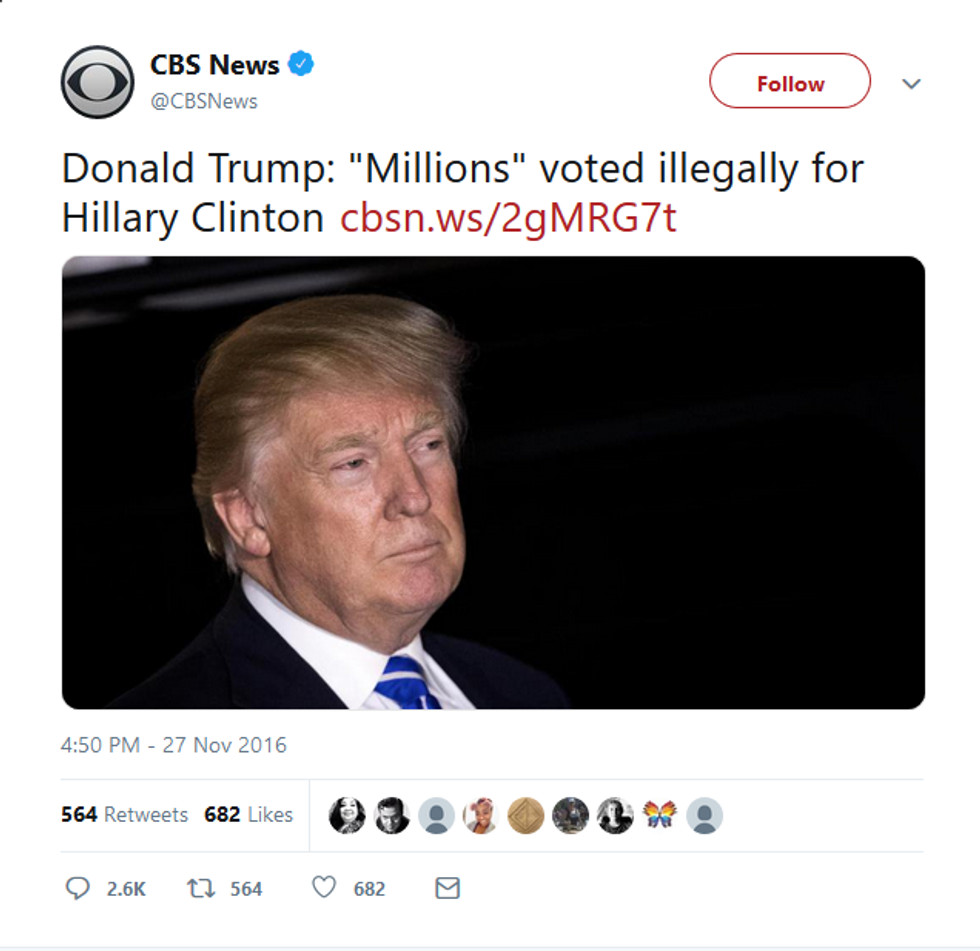
Mix these ingredients together, and you have a toxic recipe for an antidote to good journalism and truthful reporting. A prime example of how this results in destructive dishonesty is this tweeted headline from CBS News (11/27/16), sent just a few weeks after Trump was elected:
Donald Trump: 'Millions' Voted Illegally for Hillary Clinton
The central claim made by Trump here has zero basis in fact, none. Nor did he even bother to try to pretend otherwise by citing an actual source. Nonetheless, CBS News decided that Trump's outlandishly false claim, no less than a smear against our democracy, would stand alone to frame the news story about the moment.
Encouragingly, people noticed and spoke out. Three hours after CBS News's initial tweet went up--after it had mercilessly "ratioed," with thousands more angry replies than "likes"--the network posted a "clarification" reply (11/27/16) that clumsily shoehorned the qualifier "citing no evidence" into the same language as the first tweet. Notably, the first tweet remained--and does to this day. This kind of half-hearted side-stepping of accountability is, to put it mildly, not even close to satisfactory.
Still, one might have hoped that other news organizations would learn from CBS News' embarrassing mistake. And, just a few weeks after the incident, the Associated Press shared a memo from its Social Media Editor, Eric Carvin, on the AP standards blog (12/19/16) that looked like a "we get it" clarion call. In addressing the deluge of candidate lies, political deception and news impostor sites that proliferated during the 2016 election, Carvin counseled the AP's reporters and editors (emphasis added):
Let's say what we know to be true and what is false, based on our reporting. So, in headlines and copy, be clear about what we have learned and how we have learned it.
Eighteen months later, John Daniszewski, the news service's vice president for standards, offered similar advice on AP's blog (6/29/18--emphasis added):
The principle applies as well to covering tweets that a person sends or sending news alerts or headlines off a politician or official's statements on TV or in a live interview. These can be equivalent to press releases. AP standards remind us that we have a duty not to simply relay, channel or amplify such instant statements; we need to apply context and judgment -- especially if the politician is asserting something controversial, disputable or incorrect.... We always must be on guard against simply passing on information that is not factual, even in our shortest news alerts, headlines and tweets.
This is exactly right.
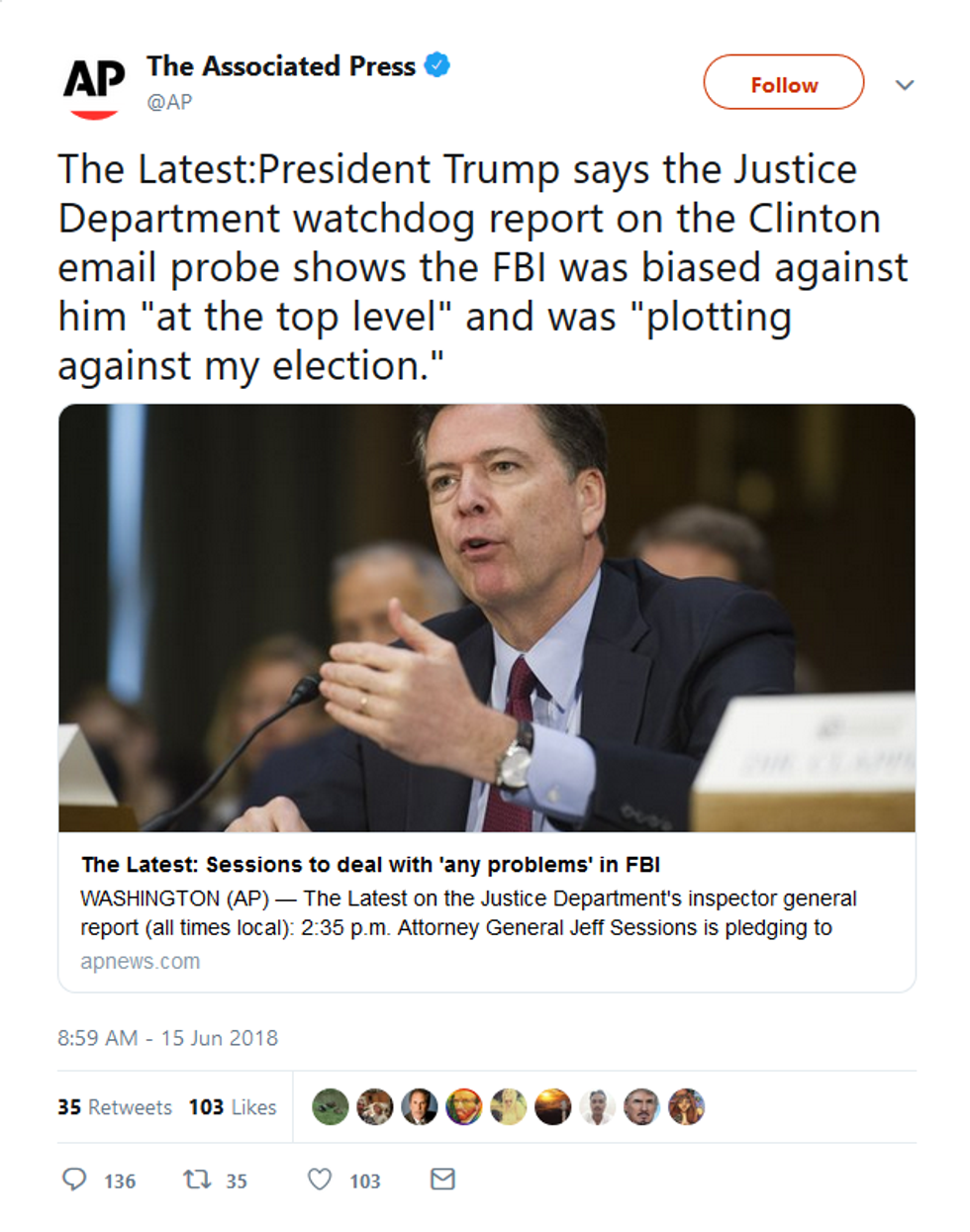
And this is also why it is so frustrating and, frankly, outrageous that the AP so often violates its own guidance, publishing Twitter headlines that are little more than unadulterated Trump/White House spin:
In fact, it's gotten so bad that, in the past six months, the AP has twice deleted tweets (including one this month) because they were so ridiculously skewed in favor of presenting the president's opinion, sans any other relevant facts.
But it's worth pointing out that despite these corrections, numerous other nakedly Trump-parroting social media headlines (among them the four cited above, which have accumulated nearly 2,000 retweets combined) remain live on the wire service's timeline. All of which suggests the AP's high-minded talk about ethical standards and providing key details is unmatched by any consistent follow-up in practice.
But the AP is far from alone. An in-depth review of the Twitter timelines of major news organizations finds almost all of them have failed to live up to this minimum standard of truth in the past two years. Time and time again, they have fallen victim to the trap of taking whatever was the latest thing to come out of Trump's mouth and reflexively turning it into a stenographic, town-crier-like "Trump says..." or "...tweeted Trump" headline.
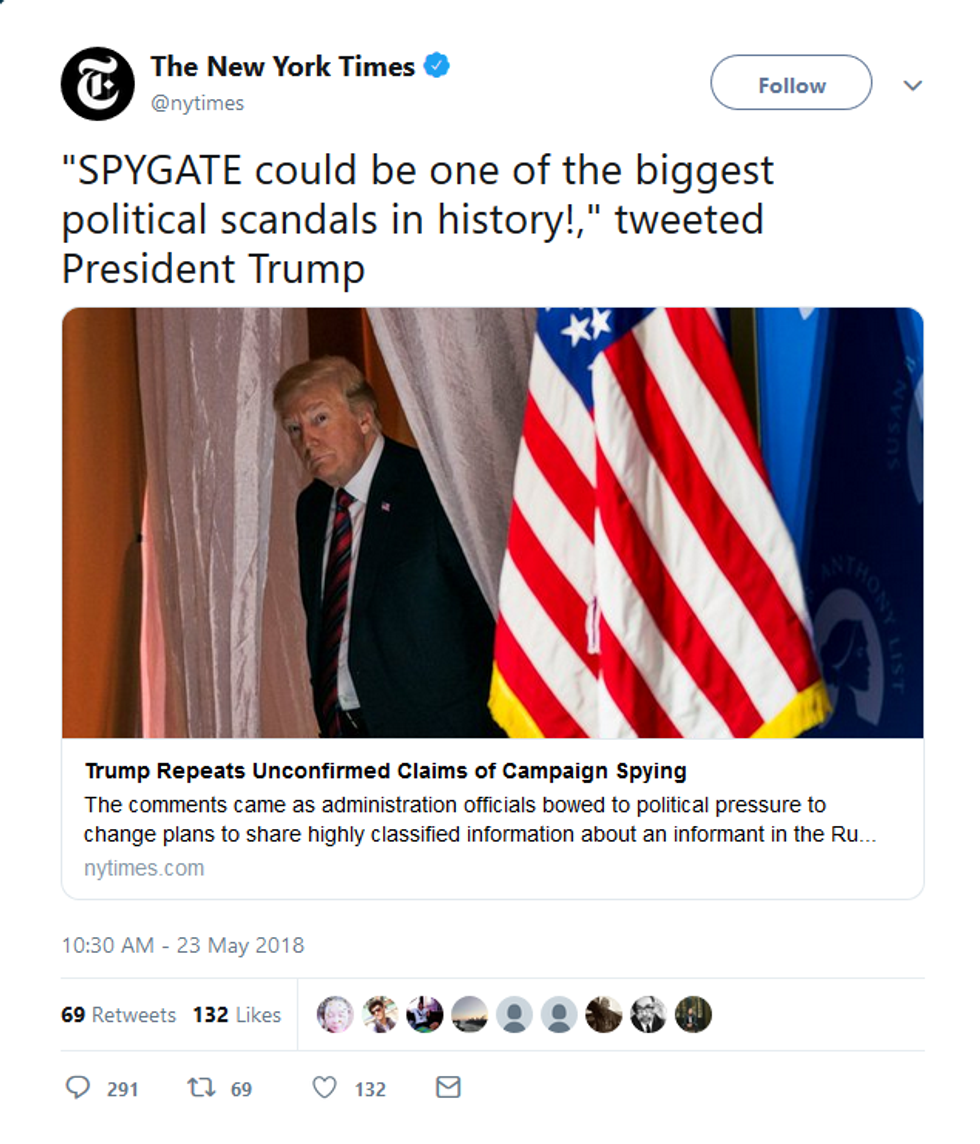
Reading these absurd examples, one witnesses a thorough abdication of the duty of the press to hold power to account, to offer a full picture of reality. It speaks to a fundamentally superficial grasp on journalism, one that accepts proclamation from on high with no visible skepticism or pushback. To quote Trump accurately while he's in the process of pushing an obviously false or misleading statement, and to then give that statement preferential placement in one's newsfeed, is to mistake faithful transcription for honest reporting.
To be fair, many of these news org tweets are structured as a "Twitter card," so they surface a photo and the actual story headline in the user's timeline. And often, the actual story headline does not suffer from this problematic "Trump says..." framing. (But note that when users quote tweet the news org's original, that information disappears.) Of course, that in itself is telling, as it suggests the mainstream press at times operates with a double standard when it comes to how it presents its news on social media vs. its own website.
Also, the excuse that social media necessitates more brevity and, hence this "Trump says..." framing, doesn't hold up. From my rough survey of dozens of this tweet genre (representative in the sample above), most used far less than Twitter's allotted 280 characters, meaning there was plenty of room to add the necessary corrective details to counter Trump's misinformation.
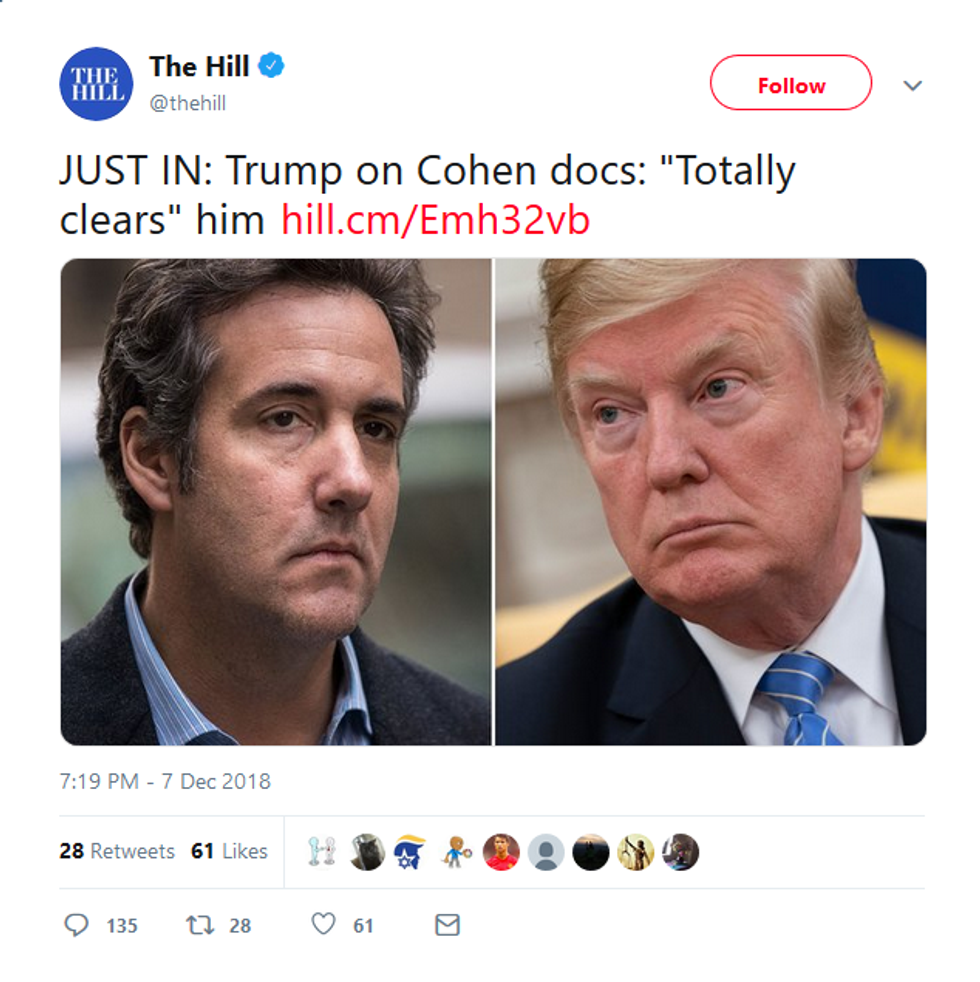
Another crutch the mainstream press subtly uses to excuse this breakdown of journalistic rigor: time. Frequently, these doing-PR-for-Trump headlines are fronted with "BREAKING" or "NEW" or "JUST IN," as if the public cannot be allowed to wait to hear the latest, frequently misleading thing the president said unchallenged:
This too is a shameless dodge. The press owes it to the public to give a complete as picture as possible, with all the relevant facts. This is even true for headlines. In fact, it is especially true for social media headlines.
Why? Well, first it's critical to understand how users engage with news on social media platforms. One joint study led by Columbia University found that six out of 10 people will share a link to a news story on social media without clicking on it. Even more troubling, as the Washington Post write-up (6/16/16) of the research notes:
These sort of blind peer-to-peer shares are really important in determining what news gets circulated and what just fades off the public radar. So your thoughtless retweets, and those of your friends, are actually shaping our shared political and cultural agendas.
And, if taking it upon oneself to actually share a news story only correlates with reading the actual story 40 percent of the time, how many fewer clicks do stories get when someone is merely scrolling past them in their Facebook news feed or Twitter timeline?
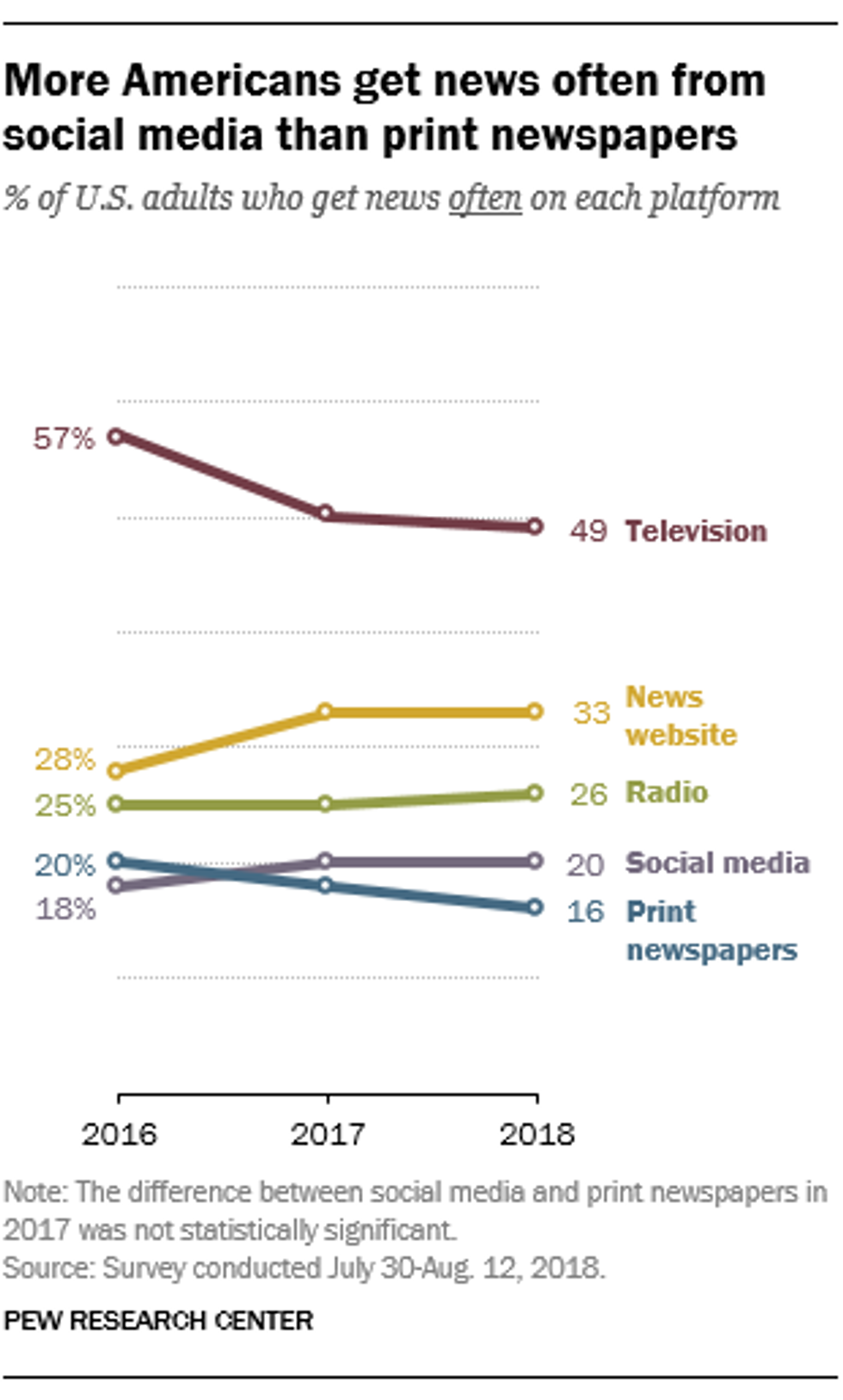
Moreover, just this week, a Pew study found that, for the first time, more Americans now "often" get their news from social media platforms than from newspapers--20 percent vs. 16 percent. (TV still dominates as the first choice for news consumers, at 49 percent.) Couple this trend with the scrolling-but-not-clicking phenomenon, and it becomes clear that social media headlines--more so than the stories they promote--play an increasingly outsized role in defining the facts and knowledge base about news topics for the public.
But these are just isolated incidents, you might say: Not every news headline on Twitter effectively endorses the president's spin. And that's true. Collectively, however, these headlines can have an insidious effect when they are clustered around the same news event--like, say, a development in one of the many investigations into President Trump.
For example, after last week's latest court filing involving his former lawyer, Michael Cohen, Trump got no less than six different news organizations--AP (12/8/18--now deleted), Reuters (12/8/18), Politico (12/8/18), NBC News (12/7/18), the Daily Beast (12/7/18) and The Hill (12/7/18)--to unilaterally repeat a version of his bizarre, divorced-from-reality claim that the latest dump of evidence about his deep involvement in campaign finance transgressions "totally clears" him.
This kind of independent, compounding reinforcement of misinformation has proven to be very powerful. Just after the 2016 election, Vanderbilt University researcher Lisa Fazio pointed out that repetition of false information can easily overwhelm the truth, even among those who know better:
Our research suggests that even people who knew Pope Francis made no presidential endorsement would be susceptible to believing a "Pope endorses Trump" headline when they had seen it multiple times.
Suffice it to say, with the public's trust in the press near all-time lows, becoming a willing handmaiden to even more political spin and dishonesty won't help return it to a healthy reputation. The good news is, however, the steps on the road to recovery are clear. As the AP's own standards team has counseled, context is key, so every professional news organization should forbid any social media headline from repeating uncorroborated or contradicted-by-evidence claims--from anyone, including, especially this president.
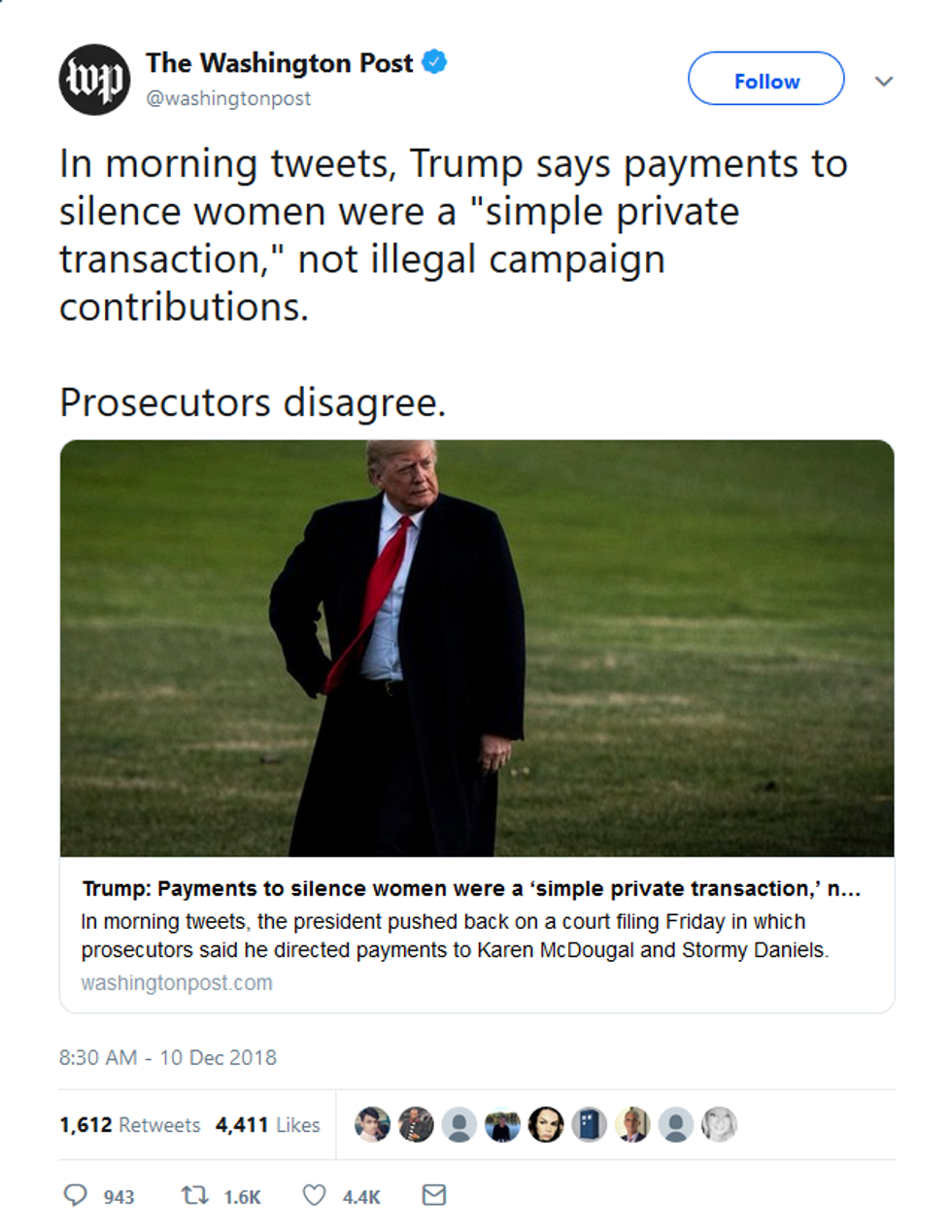
All contextual headlines are not equal, however. The Washington Post tweet (12/10/18) below, for example, pushes back on Trump's claim, but its stilted "both sides" nature gives the impression these two interpretations are merely a matter of opinion.
In morning tweets, Trump says payments to silence women were a "simple private transaction," not illegal campaign contributions. Prosecutors disagree.
Likewise, simply adding "without evidence" or stipulating something is "false" represents the bare minimum in journalistic effort. In fact, if your news org repeats the false information it is supposedly contextualizing or debunking in the headline, it could actually make things worse, since there is strong evidence that a "backfire effect" occurs when false claims are repeated, even in the context of knocking them down.
Also, attempting to cover up for a Trump-parroting tweet by merely replying to it with an amended headline, like ABC News does above, is a shoddy and counterproductive strategy, the social media equivalent of trying to unring a bell. Invariably, the original tweet gets more attention--as was the case here, where Trump's unchallenged claim via ABC News garnered more than 3,700 retweets. The "MORE" clarification got less than a tenth as many.
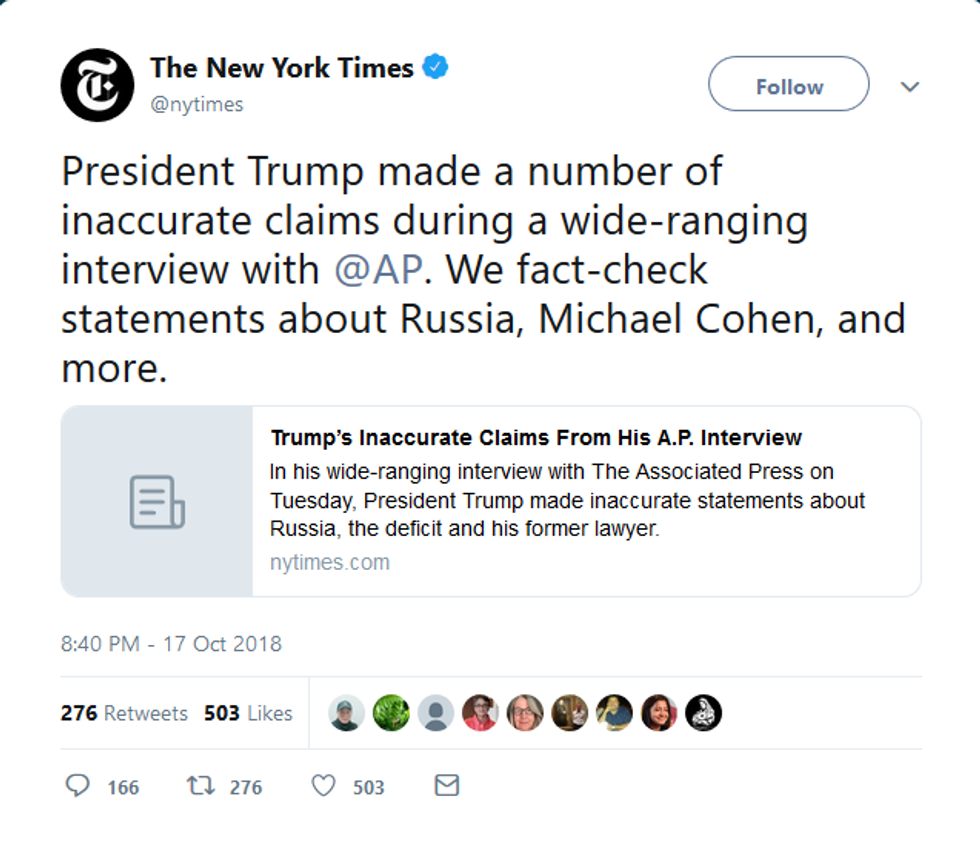
Perhaps the best response is for news organizations to structure their social media headlines as a kind of pre-buttal to the political misinformation they're reporting on, like the New York Times (10/17/18) does below:
President Trump made a number of inaccurate claims during a wide-ranging interview with @AP. We fact-check statements about Russia, Michael Cohen, and more
Note how the paper makes the false nature of his claims the central part of the news hook, while not repeating the actual claims, just the topics. In other words, the takeaway for readers is "Trump said false things," not "here are the false things Trump said." This may seem like a distinction without a difference, but, in fact, it is a critical nuance for the establishment press to grasp if it wants to staunch the flow of uncorroborated claims and outright lies that it is abetting.
The final and most important element of fixing this flawed coverage isn't structural. Instead, it requires an institutional and psychological rethink from reporters and editors. The goal: stop treating all politicians, and this president in particular, with such deference in both your coverage and how you frame it.
Being too much of a malleable conduit for the messaging of the powerful in Washington has always been a problem for the corporate media. But any vestigial benefit of the doubt granted to this president by the press creates a real risk of journalists becoming willing agents of his lies or propaganda. The vast amount of misinformation coming out of this White House has reached pandemic levels, and lazy, careless editorial hygiene on social media will only serve to spread the misinformation further. It's long past time for the press to look inward and say: Journalist, heal thyself.
Trump and Musk are on an unconstitutional rampage, aiming for virtually every corner of the federal government. These two right-wing billionaires are targeting nurses, scientists, teachers, daycare providers, judges, veterans, air traffic controllers, and nuclear safety inspectors. No one is safe. The food stamps program, Social Security, Medicare, and Medicaid are next. It’s an unprecedented disaster and a five-alarm fire, but there will be a reckoning. The people did not vote for this. The American people do not want this dystopian hellscape that hides behind claims of “efficiency.” Still, in reality, it is all a giveaway to corporate interests and the libertarian dreams of far-right oligarchs like Musk. Common Dreams is playing a vital role by reporting day and night on this orgy of corruption and greed, as well as what everyday people can do to organize and fight back. As a people-powered nonprofit news outlet, we cover issues the corporate media never will, but we can only continue with our readers’ support. |
The most basic tenet of professional physicians is the Hippocratic Oath: "First, do no harm." Its intent is clear, simple: When practicing medicine, the fundamental ethical consideration should be to not make things worse. All decisions on treatment--including whether to treat a patient in the first place--flow from that starting point.

Journalists, while they take no such professional oath, should be duty-bound to follow a similar principle when reporting the news: "First, do no harm to the truth." While our internet-era news ecosystem, like modern medicine, suffers from a number of institutional inefficiencies and dubious remedies--from endless horserace poll stories, to scoops that aren't, to mind-numbingly banal analysis--these editorial efforts should, at the very least, avoid lowering the public's overall command of the facts and reality. But increasingly, corporate news organizations are failing to clear even that low bar, and it starts--and, just as critically, ends--at their point of first contact with their readers: social media headlines.
This failure has several causes; some old, some new. The first of these involves the mainstream press's innate and long-standing deference to authority, which has the effect of warping its news judgment and wrapping its framing solely around the pronouncements of the powerful.
Another age-old problem is corporate media's habitual focus on literal, he-said, she-said narratives, rather than illuminating analysis. A more recent contributor: legacy news media's woefully inconsistent and often downright negligent understanding of how its readers engage with its posts on sites like Facebook and Twitter.
And, finally, there's the current occupant of the White House, who has demonstrated beyond a shadow of a doubt that he is a serial liar, and that taking on the responsibilities of the presidency has in no way changed that. In fact, it has only made it worse.

Mix these ingredients together, and you have a toxic recipe for an antidote to good journalism and truthful reporting. A prime example of how this results in destructive dishonesty is this tweeted headline from CBS News (11/27/16), sent just a few weeks after Trump was elected:
Donald Trump: 'Millions' Voted Illegally for Hillary Clinton
The central claim made by Trump here has zero basis in fact, none. Nor did he even bother to try to pretend otherwise by citing an actual source. Nonetheless, CBS News decided that Trump's outlandishly false claim, no less than a smear against our democracy, would stand alone to frame the news story about the moment.
Encouragingly, people noticed and spoke out. Three hours after CBS News's initial tweet went up--after it had mercilessly "ratioed," with thousands more angry replies than "likes"--the network posted a "clarification" reply (11/27/16) that clumsily shoehorned the qualifier "citing no evidence" into the same language as the first tweet. Notably, the first tweet remained--and does to this day. This kind of half-hearted side-stepping of accountability is, to put it mildly, not even close to satisfactory.
Still, one might have hoped that other news organizations would learn from CBS News' embarrassing mistake. And, just a few weeks after the incident, the Associated Press shared a memo from its Social Media Editor, Eric Carvin, on the AP standards blog (12/19/16) that looked like a "we get it" clarion call. In addressing the deluge of candidate lies, political deception and news impostor sites that proliferated during the 2016 election, Carvin counseled the AP's reporters and editors (emphasis added):
Let's say what we know to be true and what is false, based on our reporting. So, in headlines and copy, be clear about what we have learned and how we have learned it.
Eighteen months later, John Daniszewski, the news service's vice president for standards, offered similar advice on AP's blog (6/29/18--emphasis added):
The principle applies as well to covering tweets that a person sends or sending news alerts or headlines off a politician or official's statements on TV or in a live interview. These can be equivalent to press releases. AP standards remind us that we have a duty not to simply relay, channel or amplify such instant statements; we need to apply context and judgment -- especially if the politician is asserting something controversial, disputable or incorrect.... We always must be on guard against simply passing on information that is not factual, even in our shortest news alerts, headlines and tweets.
This is exactly right.

And this is also why it is so frustrating and, frankly, outrageous that the AP so often violates its own guidance, publishing Twitter headlines that are little more than unadulterated Trump/White House spin:
In fact, it's gotten so bad that, in the past six months, the AP has twice deleted tweets (including one this month) because they were so ridiculously skewed in favor of presenting the president's opinion, sans any other relevant facts.
But it's worth pointing out that despite these corrections, numerous other nakedly Trump-parroting social media headlines (among them the four cited above, which have accumulated nearly 2,000 retweets combined) remain live on the wire service's timeline. All of which suggests the AP's high-minded talk about ethical standards and providing key details is unmatched by any consistent follow-up in practice.
But the AP is far from alone. An in-depth review of the Twitter timelines of major news organizations finds almost all of them have failed to live up to this minimum standard of truth in the past two years. Time and time again, they have fallen victim to the trap of taking whatever was the latest thing to come out of Trump's mouth and reflexively turning it into a stenographic, town-crier-like "Trump says..." or "...tweeted Trump" headline.

Reading these absurd examples, one witnesses a thorough abdication of the duty of the press to hold power to account, to offer a full picture of reality. It speaks to a fundamentally superficial grasp on journalism, one that accepts proclamation from on high with no visible skepticism or pushback. To quote Trump accurately while he's in the process of pushing an obviously false or misleading statement, and to then give that statement preferential placement in one's newsfeed, is to mistake faithful transcription for honest reporting.
To be fair, many of these news org tweets are structured as a "Twitter card," so they surface a photo and the actual story headline in the user's timeline. And often, the actual story headline does not suffer from this problematic "Trump says..." framing. (But note that when users quote tweet the news org's original, that information disappears.) Of course, that in itself is telling, as it suggests the mainstream press at times operates with a double standard when it comes to how it presents its news on social media vs. its own website.
Also, the excuse that social media necessitates more brevity and, hence this "Trump says..." framing, doesn't hold up. From my rough survey of dozens of this tweet genre (representative in the sample above), most used far less than Twitter's allotted 280 characters, meaning there was plenty of room to add the necessary corrective details to counter Trump's misinformation.

Another crutch the mainstream press subtly uses to excuse this breakdown of journalistic rigor: time. Frequently, these doing-PR-for-Trump headlines are fronted with "BREAKING" or "NEW" or "JUST IN," as if the public cannot be allowed to wait to hear the latest, frequently misleading thing the president said unchallenged:
This too is a shameless dodge. The press owes it to the public to give a complete as picture as possible, with all the relevant facts. This is even true for headlines. In fact, it is especially true for social media headlines.
Why? Well, first it's critical to understand how users engage with news on social media platforms. One joint study led by Columbia University found that six out of 10 people will share a link to a news story on social media without clicking on it. Even more troubling, as the Washington Post write-up (6/16/16) of the research notes:
These sort of blind peer-to-peer shares are really important in determining what news gets circulated and what just fades off the public radar. So your thoughtless retweets, and those of your friends, are actually shaping our shared political and cultural agendas.
And, if taking it upon oneself to actually share a news story only correlates with reading the actual story 40 percent of the time, how many fewer clicks do stories get when someone is merely scrolling past them in their Facebook news feed or Twitter timeline?

Moreover, just this week, a Pew study found that, for the first time, more Americans now "often" get their news from social media platforms than from newspapers--20 percent vs. 16 percent. (TV still dominates as the first choice for news consumers, at 49 percent.) Couple this trend with the scrolling-but-not-clicking phenomenon, and it becomes clear that social media headlines--more so than the stories they promote--play an increasingly outsized role in defining the facts and knowledge base about news topics for the public.
But these are just isolated incidents, you might say: Not every news headline on Twitter effectively endorses the president's spin. And that's true. Collectively, however, these headlines can have an insidious effect when they are clustered around the same news event--like, say, a development in one of the many investigations into President Trump.
For example, after last week's latest court filing involving his former lawyer, Michael Cohen, Trump got no less than six different news organizations--AP (12/8/18--now deleted), Reuters (12/8/18), Politico (12/8/18), NBC News (12/7/18), the Daily Beast (12/7/18) and The Hill (12/7/18)--to unilaterally repeat a version of his bizarre, divorced-from-reality claim that the latest dump of evidence about his deep involvement in campaign finance transgressions "totally clears" him.
This kind of independent, compounding reinforcement of misinformation has proven to be very powerful. Just after the 2016 election, Vanderbilt University researcher Lisa Fazio pointed out that repetition of false information can easily overwhelm the truth, even among those who know better:
Our research suggests that even people who knew Pope Francis made no presidential endorsement would be susceptible to believing a "Pope endorses Trump" headline when they had seen it multiple times.
Suffice it to say, with the public's trust in the press near all-time lows, becoming a willing handmaiden to even more political spin and dishonesty won't help return it to a healthy reputation. The good news is, however, the steps on the road to recovery are clear. As the AP's own standards team has counseled, context is key, so every professional news organization should forbid any social media headline from repeating uncorroborated or contradicted-by-evidence claims--from anyone, including, especially this president.

All contextual headlines are not equal, however. The Washington Post tweet (12/10/18) below, for example, pushes back on Trump's claim, but its stilted "both sides" nature gives the impression these two interpretations are merely a matter of opinion.
In morning tweets, Trump says payments to silence women were a "simple private transaction," not illegal campaign contributions. Prosecutors disagree.
Likewise, simply adding "without evidence" or stipulating something is "false" represents the bare minimum in journalistic effort. In fact, if your news org repeats the false information it is supposedly contextualizing or debunking in the headline, it could actually make things worse, since there is strong evidence that a "backfire effect" occurs when false claims are repeated, even in the context of knocking them down.
Also, attempting to cover up for a Trump-parroting tweet by merely replying to it with an amended headline, like ABC News does above, is a shoddy and counterproductive strategy, the social media equivalent of trying to unring a bell. Invariably, the original tweet gets more attention--as was the case here, where Trump's unchallenged claim via ABC News garnered more than 3,700 retweets. The "MORE" clarification got less than a tenth as many.

Perhaps the best response is for news organizations to structure their social media headlines as a kind of pre-buttal to the political misinformation they're reporting on, like the New York Times (10/17/18) does below:
President Trump made a number of inaccurate claims during a wide-ranging interview with @AP. We fact-check statements about Russia, Michael Cohen, and more
Note how the paper makes the false nature of his claims the central part of the news hook, while not repeating the actual claims, just the topics. In other words, the takeaway for readers is "Trump said false things," not "here are the false things Trump said." This may seem like a distinction without a difference, but, in fact, it is a critical nuance for the establishment press to grasp if it wants to staunch the flow of uncorroborated claims and outright lies that it is abetting.
The final and most important element of fixing this flawed coverage isn't structural. Instead, it requires an institutional and psychological rethink from reporters and editors. The goal: stop treating all politicians, and this president in particular, with such deference in both your coverage and how you frame it.
Being too much of a malleable conduit for the messaging of the powerful in Washington has always been a problem for the corporate media. But any vestigial benefit of the doubt granted to this president by the press creates a real risk of journalists becoming willing agents of his lies or propaganda. The vast amount of misinformation coming out of this White House has reached pandemic levels, and lazy, careless editorial hygiene on social media will only serve to spread the misinformation further. It's long past time for the press to look inward and say: Journalist, heal thyself.
The most basic tenet of professional physicians is the Hippocratic Oath: "First, do no harm." Its intent is clear, simple: When practicing medicine, the fundamental ethical consideration should be to not make things worse. All decisions on treatment--including whether to treat a patient in the first place--flow from that starting point.

Journalists, while they take no such professional oath, should be duty-bound to follow a similar principle when reporting the news: "First, do no harm to the truth." While our internet-era news ecosystem, like modern medicine, suffers from a number of institutional inefficiencies and dubious remedies--from endless horserace poll stories, to scoops that aren't, to mind-numbingly banal analysis--these editorial efforts should, at the very least, avoid lowering the public's overall command of the facts and reality. But increasingly, corporate news organizations are failing to clear even that low bar, and it starts--and, just as critically, ends--at their point of first contact with their readers: social media headlines.
This failure has several causes; some old, some new. The first of these involves the mainstream press's innate and long-standing deference to authority, which has the effect of warping its news judgment and wrapping its framing solely around the pronouncements of the powerful.
Another age-old problem is corporate media's habitual focus on literal, he-said, she-said narratives, rather than illuminating analysis. A more recent contributor: legacy news media's woefully inconsistent and often downright negligent understanding of how its readers engage with its posts on sites like Facebook and Twitter.
And, finally, there's the current occupant of the White House, who has demonstrated beyond a shadow of a doubt that he is a serial liar, and that taking on the responsibilities of the presidency has in no way changed that. In fact, it has only made it worse.

Mix these ingredients together, and you have a toxic recipe for an antidote to good journalism and truthful reporting. A prime example of how this results in destructive dishonesty is this tweeted headline from CBS News (11/27/16), sent just a few weeks after Trump was elected:
Donald Trump: 'Millions' Voted Illegally for Hillary Clinton
The central claim made by Trump here has zero basis in fact, none. Nor did he even bother to try to pretend otherwise by citing an actual source. Nonetheless, CBS News decided that Trump's outlandishly false claim, no less than a smear against our democracy, would stand alone to frame the news story about the moment.
Encouragingly, people noticed and spoke out. Three hours after CBS News's initial tweet went up--after it had mercilessly "ratioed," with thousands more angry replies than "likes"--the network posted a "clarification" reply (11/27/16) that clumsily shoehorned the qualifier "citing no evidence" into the same language as the first tweet. Notably, the first tweet remained--and does to this day. This kind of half-hearted side-stepping of accountability is, to put it mildly, not even close to satisfactory.
Still, one might have hoped that other news organizations would learn from CBS News' embarrassing mistake. And, just a few weeks after the incident, the Associated Press shared a memo from its Social Media Editor, Eric Carvin, on the AP standards blog (12/19/16) that looked like a "we get it" clarion call. In addressing the deluge of candidate lies, political deception and news impostor sites that proliferated during the 2016 election, Carvin counseled the AP's reporters and editors (emphasis added):
Let's say what we know to be true and what is false, based on our reporting. So, in headlines and copy, be clear about what we have learned and how we have learned it.
Eighteen months later, John Daniszewski, the news service's vice president for standards, offered similar advice on AP's blog (6/29/18--emphasis added):
The principle applies as well to covering tweets that a person sends or sending news alerts or headlines off a politician or official's statements on TV or in a live interview. These can be equivalent to press releases. AP standards remind us that we have a duty not to simply relay, channel or amplify such instant statements; we need to apply context and judgment -- especially if the politician is asserting something controversial, disputable or incorrect.... We always must be on guard against simply passing on information that is not factual, even in our shortest news alerts, headlines and tweets.
This is exactly right.

And this is also why it is so frustrating and, frankly, outrageous that the AP so often violates its own guidance, publishing Twitter headlines that are little more than unadulterated Trump/White House spin:
In fact, it's gotten so bad that, in the past six months, the AP has twice deleted tweets (including one this month) because they were so ridiculously skewed in favor of presenting the president's opinion, sans any other relevant facts.
But it's worth pointing out that despite these corrections, numerous other nakedly Trump-parroting social media headlines (among them the four cited above, which have accumulated nearly 2,000 retweets combined) remain live on the wire service's timeline. All of which suggests the AP's high-minded talk about ethical standards and providing key details is unmatched by any consistent follow-up in practice.
But the AP is far from alone. An in-depth review of the Twitter timelines of major news organizations finds almost all of them have failed to live up to this minimum standard of truth in the past two years. Time and time again, they have fallen victim to the trap of taking whatever was the latest thing to come out of Trump's mouth and reflexively turning it into a stenographic, town-crier-like "Trump says..." or "...tweeted Trump" headline.

Reading these absurd examples, one witnesses a thorough abdication of the duty of the press to hold power to account, to offer a full picture of reality. It speaks to a fundamentally superficial grasp on journalism, one that accepts proclamation from on high with no visible skepticism or pushback. To quote Trump accurately while he's in the process of pushing an obviously false or misleading statement, and to then give that statement preferential placement in one's newsfeed, is to mistake faithful transcription for honest reporting.
To be fair, many of these news org tweets are structured as a "Twitter card," so they surface a photo and the actual story headline in the user's timeline. And often, the actual story headline does not suffer from this problematic "Trump says..." framing. (But note that when users quote tweet the news org's original, that information disappears.) Of course, that in itself is telling, as it suggests the mainstream press at times operates with a double standard when it comes to how it presents its news on social media vs. its own website.
Also, the excuse that social media necessitates more brevity and, hence this "Trump says..." framing, doesn't hold up. From my rough survey of dozens of this tweet genre (representative in the sample above), most used far less than Twitter's allotted 280 characters, meaning there was plenty of room to add the necessary corrective details to counter Trump's misinformation.

Another crutch the mainstream press subtly uses to excuse this breakdown of journalistic rigor: time. Frequently, these doing-PR-for-Trump headlines are fronted with "BREAKING" or "NEW" or "JUST IN," as if the public cannot be allowed to wait to hear the latest, frequently misleading thing the president said unchallenged:
This too is a shameless dodge. The press owes it to the public to give a complete as picture as possible, with all the relevant facts. This is even true for headlines. In fact, it is especially true for social media headlines.
Why? Well, first it's critical to understand how users engage with news on social media platforms. One joint study led by Columbia University found that six out of 10 people will share a link to a news story on social media without clicking on it. Even more troubling, as the Washington Post write-up (6/16/16) of the research notes:
These sort of blind peer-to-peer shares are really important in determining what news gets circulated and what just fades off the public radar. So your thoughtless retweets, and those of your friends, are actually shaping our shared political and cultural agendas.
And, if taking it upon oneself to actually share a news story only correlates with reading the actual story 40 percent of the time, how many fewer clicks do stories get when someone is merely scrolling past them in their Facebook news feed or Twitter timeline?

Moreover, just this week, a Pew study found that, for the first time, more Americans now "often" get their news from social media platforms than from newspapers--20 percent vs. 16 percent. (TV still dominates as the first choice for news consumers, at 49 percent.) Couple this trend with the scrolling-but-not-clicking phenomenon, and it becomes clear that social media headlines--more so than the stories they promote--play an increasingly outsized role in defining the facts and knowledge base about news topics for the public.
But these are just isolated incidents, you might say: Not every news headline on Twitter effectively endorses the president's spin. And that's true. Collectively, however, these headlines can have an insidious effect when they are clustered around the same news event--like, say, a development in one of the many investigations into President Trump.
For example, after last week's latest court filing involving his former lawyer, Michael Cohen, Trump got no less than six different news organizations--AP (12/8/18--now deleted), Reuters (12/8/18), Politico (12/8/18), NBC News (12/7/18), the Daily Beast (12/7/18) and The Hill (12/7/18)--to unilaterally repeat a version of his bizarre, divorced-from-reality claim that the latest dump of evidence about his deep involvement in campaign finance transgressions "totally clears" him.
This kind of independent, compounding reinforcement of misinformation has proven to be very powerful. Just after the 2016 election, Vanderbilt University researcher Lisa Fazio pointed out that repetition of false information can easily overwhelm the truth, even among those who know better:
Our research suggests that even people who knew Pope Francis made no presidential endorsement would be susceptible to believing a "Pope endorses Trump" headline when they had seen it multiple times.
Suffice it to say, with the public's trust in the press near all-time lows, becoming a willing handmaiden to even more political spin and dishonesty won't help return it to a healthy reputation. The good news is, however, the steps on the road to recovery are clear. As the AP's own standards team has counseled, context is key, so every professional news organization should forbid any social media headline from repeating uncorroborated or contradicted-by-evidence claims--from anyone, including, especially this president.

All contextual headlines are not equal, however. The Washington Post tweet (12/10/18) below, for example, pushes back on Trump's claim, but its stilted "both sides" nature gives the impression these two interpretations are merely a matter of opinion.
In morning tweets, Trump says payments to silence women were a "simple private transaction," not illegal campaign contributions. Prosecutors disagree.
Likewise, simply adding "without evidence" or stipulating something is "false" represents the bare minimum in journalistic effort. In fact, if your news org repeats the false information it is supposedly contextualizing or debunking in the headline, it could actually make things worse, since there is strong evidence that a "backfire effect" occurs when false claims are repeated, even in the context of knocking them down.
Also, attempting to cover up for a Trump-parroting tweet by merely replying to it with an amended headline, like ABC News does above, is a shoddy and counterproductive strategy, the social media equivalent of trying to unring a bell. Invariably, the original tweet gets more attention--as was the case here, where Trump's unchallenged claim via ABC News garnered more than 3,700 retweets. The "MORE" clarification got less than a tenth as many.

Perhaps the best response is for news organizations to structure their social media headlines as a kind of pre-buttal to the political misinformation they're reporting on, like the New York Times (10/17/18) does below:
President Trump made a number of inaccurate claims during a wide-ranging interview with @AP. We fact-check statements about Russia, Michael Cohen, and more
Note how the paper makes the false nature of his claims the central part of the news hook, while not repeating the actual claims, just the topics. In other words, the takeaway for readers is "Trump said false things," not "here are the false things Trump said." This may seem like a distinction without a difference, but, in fact, it is a critical nuance for the establishment press to grasp if it wants to staunch the flow of uncorroborated claims and outright lies that it is abetting.
The final and most important element of fixing this flawed coverage isn't structural. Instead, it requires an institutional and psychological rethink from reporters and editors. The goal: stop treating all politicians, and this president in particular, with such deference in both your coverage and how you frame it.
Being too much of a malleable conduit for the messaging of the powerful in Washington has always been a problem for the corporate media. But any vestigial benefit of the doubt granted to this president by the press creates a real risk of journalists becoming willing agents of his lies or propaganda. The vast amount of misinformation coming out of this White House has reached pandemic levels, and lazy, careless editorial hygiene on social media will only serve to spread the misinformation further. It's long past time for the press to look inward and say: Journalist, heal thyself.